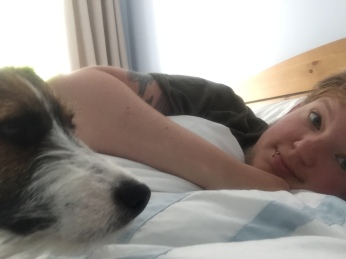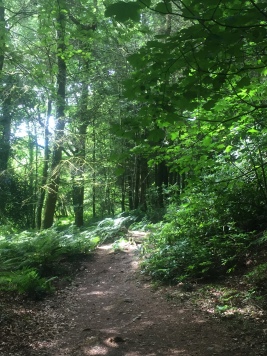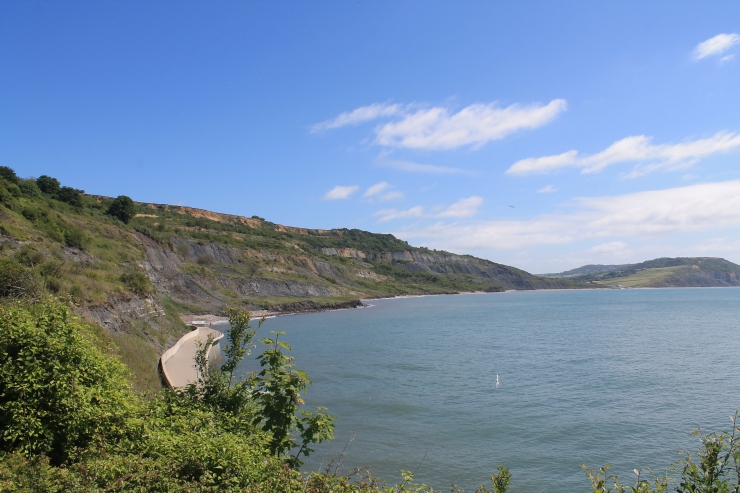The pastel array of Regency houses and the smattering of older buildings that line The Street in Charmouth are not numbered. They have names like Monk’s Rest, Askew House, Lilliputian, Red Bluff, Alicia, Melville, and, inexplicably, Swiss Cottage (which did not appear to be in any way Swiss, nor did it architecturally resemble a cottage). As a result, Google is no help here.

My Air BnB host had assured me the night before that there was a lovely clifftop path that I could walk to reach Lyme Regis. Google said that such a path no longer existed, and that the SoW Coast Path was diverted due to clifftop instability. I was up and ready to wander by 8:30am thanks in part to a wakeup call by Daisy, a 11 month old terrier mix whose wet nose is much more effective than Strum, Twinkle, Radar, or even Duck.
After letting Daisy out to ‘do her business’ in the back garden, I proceeded west, uphill, along the road until I reached a SW Coast Path diversion sign. It seemed to point across the road, where a paved path lead to a subsequent crossing of A3052 (something like a county or state highway in America). It took me north, away from the sea, but, as it was a diversion, I followed along and hoped to get closer to the sea eventually. There was a caravan park (a campground in a field, because almost all camping in the UK is in fields recently used by sheep and cattle, who have left mementos so you won’t forget them) and a graveyard where the pavement ended. A cursory glance revealed signs indicating that the garden ahead was private property. Realising I must have been lead astray, I retraced my steps back across the A road, which was getting busier by now, and climbed the steps that lead into a pasture to the south. There was no clear indication where the footpath went from there. The only way forward seemed to be a muddy tract parallel to the roadway I had just left. Insects complained to one another over pools of water shaped like ruminant limbs. A few sticks of varying sizes lay across the muck.
I decided to risk crossing, and balanced myself on the first log. It wobbled but held. I scanned for the next safe place to step. I shifted my weight from right foot to left in order to more gracefully proceed. About half way to the dry, green grassy knoll on the other side, I got stuck. There wasn’t another clear place to put my foot, and I didn’t have the patience to work my way back. I took a chance, and ended up ankle deep in faecal scented mud. Well, it’s happened now, might as well embrace it. I bravely forded ahead, throwing caution and concern for my new shoes, which had just come out of the wash after a similar incident in a horse pasture, to the wind. A handful of squelching steps later, I was across. I did my best to wipe the largest chunks of mud from the laces in my shoes and off my ankles in the tall grass.
There was still no evidence of a footpath leading to the well-earned view of the sea. I circumnavigated the paddock, and found I had reached a fence-enforced dead end. I also found several dry, non-perilous paths across to the first pasture uphill from the miniature Bog of Eternal Stench I had crossed. Shoulders slightly drooping, I climbed over the gate that lead, unimpressively, back to the path along the roadway.

Just past the Fernhill Hotel there were signs again, and the path lead through a lovely section of the path that reminded me of Forest Park. Less than a half-mile later, disappointingly, the trees gave way to a ridiculously manicured green lawn. No one yelled ‘fore’, but the whack of iron against plastic was enough warning to keep me from stepping out of the trees too quickly. Looking both ways for golf carts and old men with big sticks, I followed the yellow marks across the golf course. I was feeling out of place and less than welcome in my black leggings, second-hand athletic top, and backpack. At least there were a few other couples coming the opposite direction that looked equally ill-suited for a Pimm’s Cup in the Lyme Regis Golf Clubhouse.
Here the footpath disappeared and road-walking commenced, downhill this time. My irritation with the golf course dissipated as I realised that the view I was descending upon was likely quite similar to what Mary Anning may have seen (though probably more populous) on her way back from hunting fossils on the Black Venn. The trail cut into the woods once more. A thick coating of dry leaves and needles made walking sound like someone rustling a newspaper, and there wasn’t so much a path as a faint evidence of others having shuffled down. I aimed for the gate at the bottom of the hill and found myself in yet another pasture. This one actually allowed a few glimpses of the sea and Golden Cap beyond Lyme Bay. I imagined Mary’s dog Tray, who looked a bit like Daisy, frolicking along at her ankles and running ahead to terrorise the cows and calves. Having had a few run ins with aggressively broody cows as a child, I was glad I was walking alone.
Another gate marked with the acorn symbolising the SW Coast Path lead towards town and a parking lot, which somewhat dampened the sense of walking in Mary’s footsteps. A sign informed visitors that there were 114 steps down to the sea, which I happily descended. A placard informed me that the tall grasses to the right were home to various insects and critters not found anywhere else in the UK.

I found a shady table at The Lyme Bay right next to the museum, where I enjoyed a well-earned vegetarian full English breakfast and observed the pensioners and young parents on holiday. While there didn’t seem to be many locals dining there, almost everyone seemed to be English, much like in Mary Anning’s time. Lyme Regis became an attraction when things with France were less congenial, providing of wealthy vacationers to purchase her curios as souvenirs of their summer trip to the coast.
The museum, where I booked a place on the fossil walk that started in an hour, is built on the site of Mary Anning’s old home and curio shop. That building was destroyed in a fire, and subsequently demolished in 1889 to make way for the museum. The ground floor of the museum has numerous displays about life in Lyme Regis through the ages. I was particularly enchanted by ‘The Cabinet of Curiosities‘ built by puppetry wizards of Forkbeard. I watched all the videos installed around the sides of the cabinets, looked in drawers, and even laid on the floor underneath the cabinet to experience what it is like to be a prehistoric trobolite. On the floor above was what I had come to see, though. Displays of some of the prehistoric marine reptiles Mary had dedicated her life to studying filled the space. The displays were more personable and intimate, although less numerous, than those at the Natural History Museum in London. It is one of the best museum installations I have seen, and I could easily have spent hours in the small room, had I not had a date with the fossil guys.





